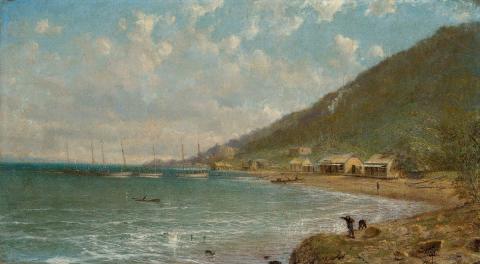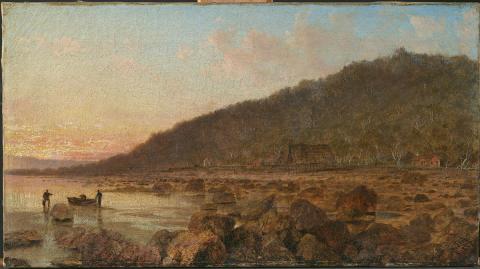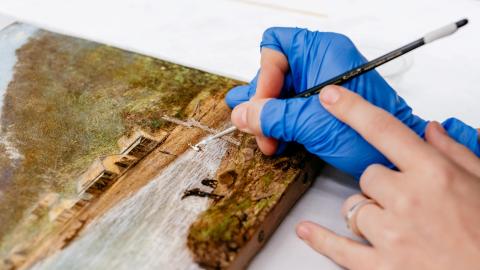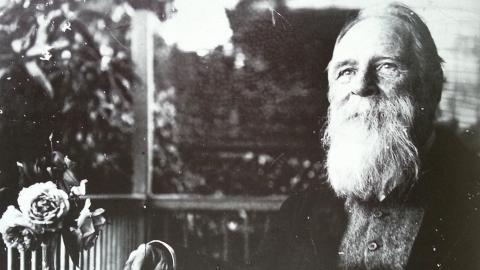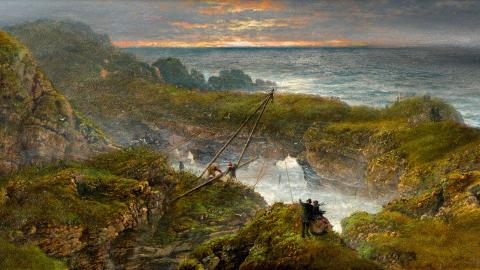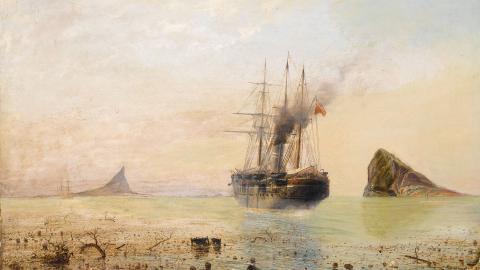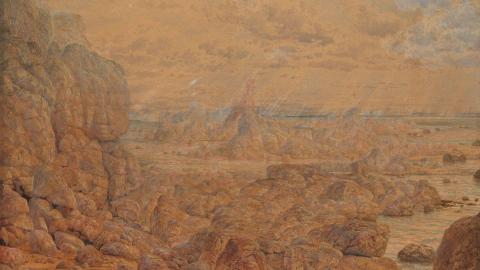Jenner’s journey to Brisbane
‘Isaac Walter Jenner: A Feeling For Light’
By Sally Stewart
September 2023
Marine artist and landscape painter Isaac Walter Jenner departed Plymouth, England on 1 August 1883. Along with his wife, Mary, their seven children and future son-in-law, Jenner was bound for Brisbane aboard the Royal Mail Ship, Roma. After leaving the British Navy in 1865, he had pursued an artistic career but his lack of formal education and artistic training impeded his success. Disillusioned with the Brighton art establishment, the Jenner family emigrated to Australia. As he travelled, Jenner was inspired to sketch his observations for future artworks, with some of his most striking capturing the aftermath of the eruption of Krakatoa.

The Gibbs, Bright & Co. wharf on Eagle Street as the Jenner family saw it upon arrival in 1883 (Anonymous / Old Custom’s House, looking up Queen Street ‘S.S. Warrego’ moored on the Brisbane River, 1883 (detail) 1883 / Robert Augustus Henry L’Estrange Collection, 2019 / Courtesy: Queensland University of Technology)
Gallery view: Isaac Walter Jenner as a young seaman in the Royal Navy, and a map of Brisbane in 1884, showing where the Jenner family alighted from the Francis Cadell.
After an extraordinary two-month journey — with four hundred other passengers on the RMS Roma — arriving in Brisbane would have been a great relief. Jenner and family disembarked at the Gibbs, Bright & Co. wharf next to the old Customs House on Eagle Street on 26 September 1883.1 2
Setting out from England in August, RMS Roma stopped in Malta before passing through the recently opened Suez Canal, considered one of the greatest engineering feats of the nineteenth century. After leaving Aden on 22 August 1883, the Jenners arrived in Batavia (Jakarta) on 6 September 1883 — to the devastating aftermath of the Krakatoa eruption.

Parker & Coward / ‘Plate 1’ from The eruption of Krakatoa, and subsequent phenomena. Report of the Krakatoa Committee of the Royal Society 1888 / London, Trubner & Co. / Image courtesy: Wikimedia
Krakatoa, located in the Sunda Strait, had been active since May 1883; however, the main volcanic explosion occurred on 27 August 1883. Its force was felt and heard as far away as Alice Springs, 3500km to the southeast.3 Jenner and his family would have heard the explosion — still the loudest sound ever recorded — on board the RMS Roma and witnessed large waves going under the ship's bow.
Jenner sketched the RMS Roma pushing through the pumice stone, the debris of twisted foliage and the remnants of Krakatoa while travelling through the Sunda Strait. He exhibited a watercolour, SS Roma passing through the pumice stones off Krakatoa, in his first exhibition in Brisbane, on 20 August 1884 at the Queensland National Association Exhibition.4
In Jenner's oil composition Krakatoa 1887, the Dutch man-of-war Prince Heinrich is seen in the distance to the left. The captain of the Prince Heinrich is warning Captain Mann of the RMS Roma that the main passage taken by steamers had been blocked by the reef newly formed by the eruption.5 The RMS Roma came close to being shipwrecked — but danger was averted, and the vessel continued to Batavia.6

In Krakatoa 1887 (Oil on canvas / 61.5 x 92cm / Image courtesy: Bonhams), Isaac Walter Jenner depicts RMS Roma sailing through the Sunda Strait on 6 September 1883, days after the eruption of Krakatoa.
They docked in Batavia (Jakarta) for three days, where they likely would have been privy to extensive reports of the tragic death toll. At least 30 000 people perished as a result of the volcanic explosion and the ensuing tidal waves that devastated the area.7
The city was covered in thick ash, completely blocking daylight at one stage where noon turned to night after the main explosion on 27 August 1883.8 Ironically, the millions of tons of ash hurled into the upper atmosphere from Krakatoa augmented Jenner's signature sunset artworks for many years. JMW Turner's artwork had a similar experience after the eruption of the Indonesian volcano Mt Tambora in 1815.9

Departing Batavia on 9 September 1883, RMS Roma headed south-east for Waiben (Thursday Island) in the Torres Strait, a major centre for the lucrative pearl-shell industry at the time.10, 11 To Jenner and his family, the northern group of islands between New Guinea and the mainland would afford an extraordinary first impression of Australia.
As Jenner sailed close to Waiben, he sketched the pearl shell stations on Muralag (Prince of Wales Island) and Giralag (Friday Island).12 He recorded his impressions of the diversity of those working on the pearl luggers in the surrounding passage and harbour in works that have become some of QAGOMA’s most recent (and most recently restored) acquisitions: Kelly & Cussen’s… 1897 and O’Hagan & McAlister’s… 1897.
To Jenner and his family, experiencing the aftermath of Krakatoa, a near shipwreck, and their remarkable first impressions of their new home would have been a challenging contrast to the sensibilities of Brighton, England.
The RMS Roma sailed the inside passage to Brisbane, stopping at Cooktown, Townsville and Bowen, before arriving in Moreton Bay at noon on Wednesday 25 September 1883. That night, Jenner and his family remained on board the Roma, most likely watching the sunset over the bay for the first time. The following day, they travelled to Brisbane on the steamer Francis Cadell to the Eagle Street wharves — to a new life.13
Twelve years later, in 1895, Jenner had his large masterpiece, Cape Chudleigh, Coast of Labrador 1895, accepted by the Queensland National Art Gallery for its foundation collection.

Sally Stewart is Curatorial Volunteer, Australian Art, at QAGOMA.
Endnotes
- ‘The recent catastrophe in the Strait of Sunda’, Brisbane Courier, 26 September 1883, p.5.
- TP Pugh, Pugh’s Almanac street map of Brisbane 1884, State Library of Queensland, accessed July 2023, https://collections.slq.qld.gov.au/viewer/IE423999
- Gavin Fry & Bronwyn Mahony, Isaac Walter Jenner, Beagle Press, Sydney, 1994, p.22.
- Julie K Brown & Margaret Maynard, Fine Arts Exhibitions in Brisbane 1884–1916, Fryer Memorial Library, University of Queensland, Brisbane, 1980, p.4.
- Brisbane Courier, 26 September 1883, p.5.
- Brisbane Courier, p.5.
- Brisbane Courier, p.5
- Brisbane Courier, p.5.
- Simon Winchester, Krakatoa: The Day the World Exploded: 27 August 1883, Viking, London, 2003, p.283.
- ‘RMS Roma’, Telegraph, 26 September 1883, p.2.
- ‘European news by electric cable: Reuter’s Agency – Miscellaneous’, Queenslander, 15 September 1883, p.430.
- Sailing through the deep-water passage between Goode and Friday Islands, RMS Roma travelled past Prince of Wales Island to dock at Thursday Island for 24 hours on 17 September 1883. Queensland Maritime Museum research assistance courtesy of David Jones and Keith Boulton.
- ‘Arrival of the Roma’, Brisbane Courier, 26 September 1883, p.5.
Explore ‘A Feeling For Light’

Digital Story Introduction
ISAAC WALTER JENNERIsaac Walter Jenner: Curating a feeling for light
Read ESSAYDigital story context and navigation
ISAAC WALTER JENNERExplore the story

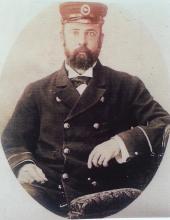
![Theophilus Parsons Pugh [publisher] / Australia/England 1831–1896 / <em>Pugh’s Almanac street map of Brisbane</em> 1884 / Image courtesy: State Library of Queensland A detailed map of Brisbane from 1884, showing the Brisbane River snaking along the bottom half of the image.](/sites/default/files/styles/medium/public/2023-08/11453_Isaac_Walter_Jenner_Image_Edits_v13.jpg?itok=6gruyjF6)
![Theophilus Parsons Pugh [publisher] / Australia/England 1831–1896 / <em>Pugh’s Almanac street map of Brisbane</em> (detail) 1884 / Image courtesy: State Library of Queensland A detailed map of Brisbane from 1884, showing where the Jenner family alighted from the Francis Cadell.](/sites/default/files/styles/medium/public/2023-08/11453_Isaac_Walter_Jenner_Image_Edits_v13_tight%20crop_0.jpg?itok=-Y9T6d0e)
